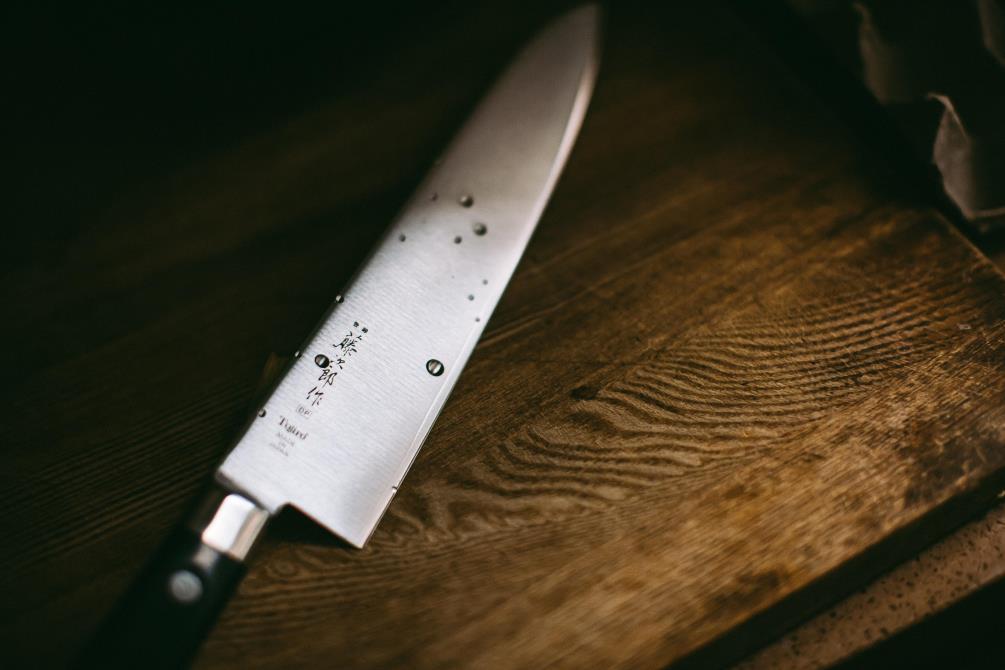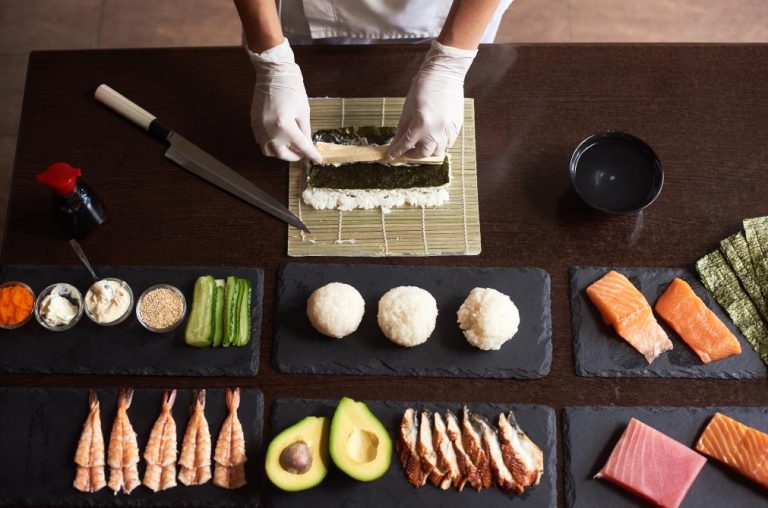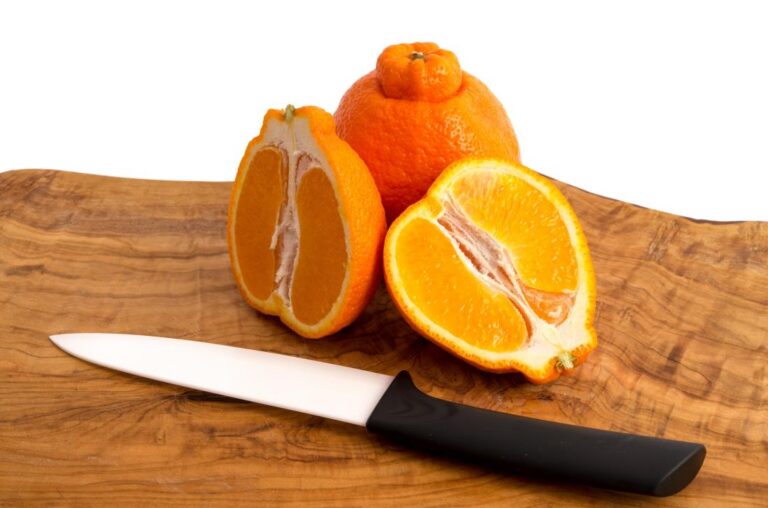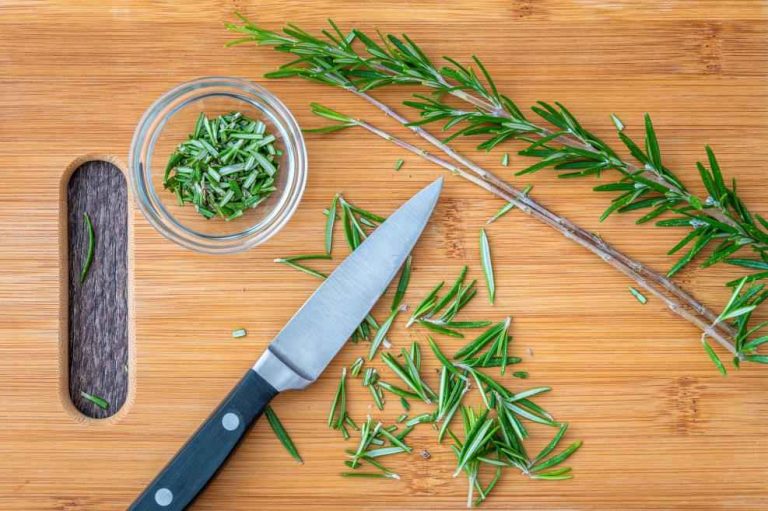Translating to cow sword, Gyuto is a multi-purpose Japanese kitchen knife. It resembles the typical western chef’s knife in many ways, but there are some significant differences we need to cover.
It’s common for knife shoppers to mistake Gyuto with the standard chef’s knife, especially if it comes with a western handle. For many, the Japanese wa-handle is the only way to distinguish the two. While they share their fair similarities, Gyuto has many different qualities.
This article will cover everything you need to know about this all-purpose Japanese kitchen knife, the varieties, and the technical details.
Origins of Gyuto
Japanese cuisine has primarily soft ingredients, like fish, various vegetables, and roots. Cutting these doesn’t require a sturdy blade. Added with the liking for finely slicing, a razor-sharp blade with good edge retention is what the Japanese favor.
The types of kitchen knives forged went on to manage these needs until Japan opened after the end of Sakoku. The traders began bringing meats. Once a country with a diet of primarily fish and vegetables quickly adopted red meat.
That’s when the need for a dedicated meat butchering knife became more apparent. This was the birth of Gyuto – by taking the western chef’s knife and tweaking it with the Japanese image of what makes good kitchen cutlery.
Gyuto knife design
Gyuto is a distinct knife with characteristics only a curious eye can see to differentiate from other all-purpose kitchen knives. Here are the most notable features of Gyuto, covering it entirely.
Blade
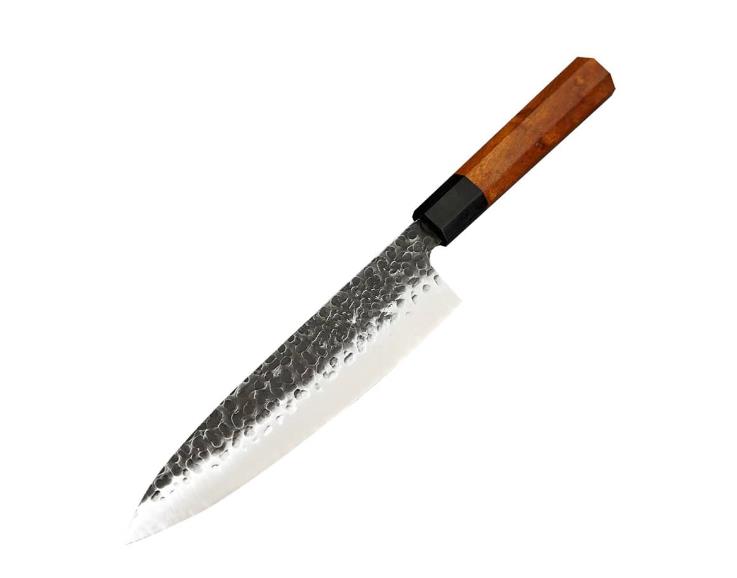
While the typical chef’s knives have a consistently curving edge, Gyuto is flatter in comparison. The edge is somewhat straight from the heel to the belly but enough to rock chop. The curvature is more evident from the belly to the end, forming a pointy tip.
The not-as-curved edge is accommodating for several reasons, at least to Japanese chefs. The push cutting technique is standard for Japanese cooks, especially when chopping ingredients by moving the blade up and down.
A flatter edge up to the belly makes this more manageable and ensures the cook chops everything on the cutting board evenly. Nonetheless, the steep curve towards the tip is suitable for rock chopping. This makes Gyuto ideal for utilizing different cutting techniques.
The curve at the tip also enables fine slicing and helps with detailed work, like trimming fat, removing connective tissue, and scoring meat.
Gyuto has a thin blade, anywhere from 1.5mm to 5mm, with 3mm thickness being the most common. A standard kitchen knife is usually 5mm. Set side by side, Gyuto has a much thinner blade.
The thin blade makes Gyuto lighter and easier to control. It doesn’t tire the cook much when chopping and slicing for long hours, especially if it has a traditional wa-handle as it isn’t heavy.
Buy Wholesale Knives and Start Scaling up with Us Today
Contact us and connect with a sales rep to get a free quote.
Bevel
Gyuto has a double bevel. Despite the favorable aspects of single-bevel Japanese knives, the chisel edge doesn’t help with everyday use as greatly as delicate slicing.
Some sellers are intrigued by single bevel kitchen knives and think it suits their target customers more. If this sounds like you, we recommend reading more about Kiritsuke.
Saying Gyuto has a double bevel and ending the conversation would be missing out on some crucial details. Almost all western knives have a double bevel, meaning they are ground on both sides.
A small detail, yet, the grinding angle makes all the difference. One of the main reasons why Japanese kitchen knives are sharper than their alternatives is this. Most Japanese kitchen knives, including Gyuto, have a sharpening angle of 10 to 15 degrees. With German knives, it’s at 20 to 25.
This difference in the edge angle makes Japanese kitchen knives sharper but more fragile at the same time. The delicate edge is the main reason we don’t recommend using them with force. Exerting anything more than necessary can damage the blade.
Handle
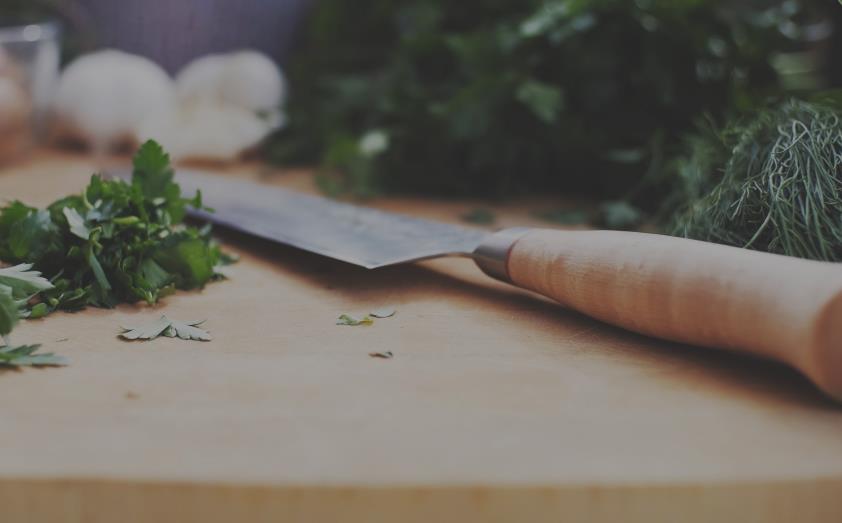
By standard, Gyuto has the Japanese wa-handle. It can also have a western-style handle, like any Japanese kitchen knife embraced by the West.
The wa-handle is an option the seller should consider if they’re marketing to professionals. The less weight at the tang and the handle itself shifts the knife’s balance forward. This change in balance compared to other alternatives aids when chopping and slicing – a beneficial trait that professionals take as an advantage.
Still, the wa-handle isn’t as popular among cooks familiar with the grip of the regular knife handle. Holding the wa-handle can almost feel as if they will drop the knife at any moment. This unfamiliarity with the wa-handle is why knifemakers also fit Japanese blades with other types of handles.
Overall, we can say the following about Gyuto’s design to summarize everything.
- Gyuto has a straight edge from the heel to the belly, transitioning to a curved tip.
- It’s thin and light.
- Knifemakers equip Gyuto with both the traditional Japanese handle and the western handle.
- Gyuto has a more acute sharpening angle. It requires the sharpener to hold the blade flatter on the whetstone, which can be difficult for beginners.
- Gyuto comes in various blade lengths, from 7 to 14 inches.
Gyuto knife uses
How Gyuto emerged makes its uses clear. It’s a knife designed for cutting meat in the way Japanese chefs favor. However, Gyuto, as we have today, is capable of handling more than just butchering beef.
Gyuto is the equivalent of a chef’s knife for Japanese cooks, where it can be employed for various tasks. After all, it’s an all-purpose kitchen knife with a specialty for cutting meats.
Everyday use
The Japanese Gyuto is ideal for everyday use in all aspects of meal preparation. Slicing, chopping, dicing, mincing, and any other duty that a cook would expect from a knife, Gyuto can deliver.
Where Gyuto stands out in these tasks is its ability to continuously deliver top performance. The Japanese Gyuto is primarily forged from hard steel with a fine grain structure that gives the blade outstanding sharpness and edge retention.
These traits can be found across many other Japanese kitchen knives. Gyuto is one of the best blades for day-to-day use if the cook doesn’t demand robust work.
Cutting meat
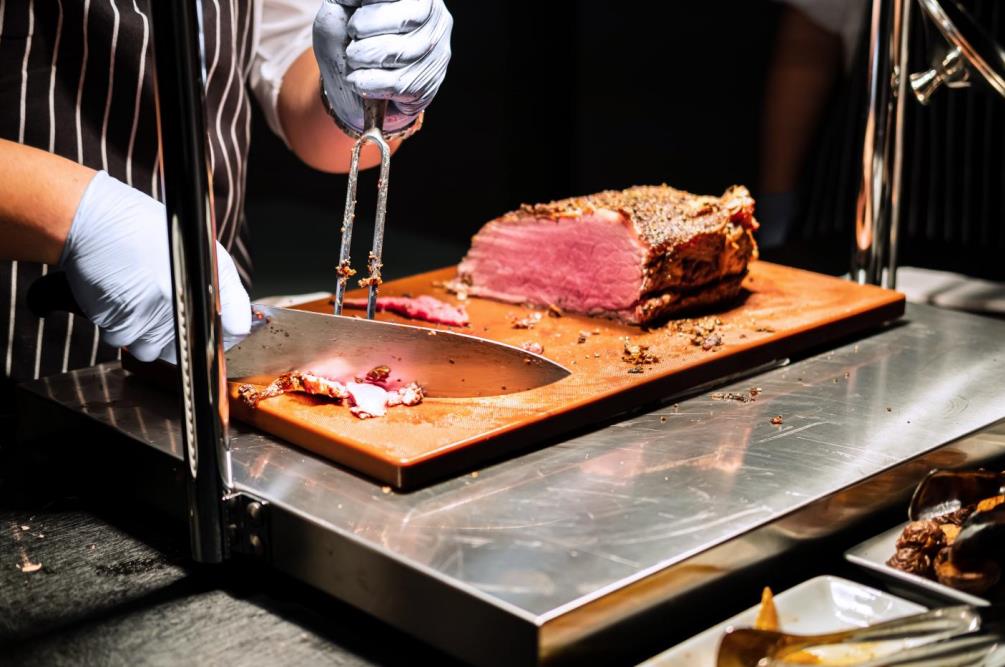
Despite having an entirely different blade design than a standard butchering knife, like the boning knife, Gyuto can break down large slabs, disjoint, trim fats, filet, and separate the meat from the bone. Gyuto is a unique kitchen knife for every cook, paired with the capability to use it for general work.
Using Gyuto solely for cutting meat would mean sacrificing many of its features. However, Japanese butchers utilize the traits of Gyuto, which would help chop or slice ingredients for other cooks in decorative work. When a Japanese butcher has a sizable cut in front of them and needs to trim it for display, Gyuto is the first knife they pick up.
Fine slicing
As mentioned, Gyuto has a thin blade profile. It won’t finely slice protein as well as Yanagiba would, but it’s ideal when you need to get the job done. However, the wide blade at the belly and heel may create traction and tear up the slices.
That’s why Gyuto’s tip is best used for this. Slicing with this part of the blade by pull cutting for soft and push cutting for denser ingredients delivers the optimal results.
Different types of Gyuto
Gyuto is over a hundred years old, and no wonder time has allowed Japanese knifemakers to experiment with different variations of this knife. Some are widely popular among certain cooks. Here are the two most common types of Gyuto.
Wa-gyuto
Wa-Gyuto is the same blade with a different handle from a non-Japanese perspective. Gyuto fitted with the traditional wa-handle is the wa-Gyuto. So, there isn’t a difference with the blade. This type of Gyuto is what buyers will mostly find in Japanese kitchen knife stores.
Although the handle might be a minor distinction for some, it can change everything about the knife. As mentioned above, if the cook isn’t familiar with the wa-handle, it can feel strange and take their confidence away.
Sellers can order Gyuto with western-style handles, known as yo-gyuto, to satisfy the needs of their customers – more on how you customize a Gyuto with us below.
Kiritsuke gyuto
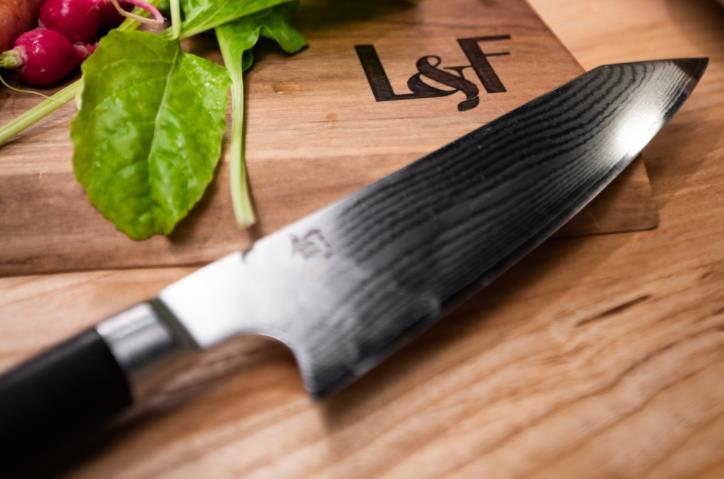
The Kiritsukte Gyuto is a mix of these two different Japanese kitchen knives. This Gyuto variation is ideal for those who slice more often and utilize pull and push cutting techniques the most often.
Kiritsuke Gyuto has a double bevel and a flatter edge than the typical Gyuto. Like Kiritsuke, it also has a triangular tip. These traits make it ideal for delicate slicing without sacrificing easy chopping and mincing. The cooks that don’t rock the blade and slice more can benefit from this version of Gyuto more than the standard version.
Gyuto vs. regular chef’s knife
First and foremost, the use of Gyuto and the regular chef’s knife we all know are pretty much identical. The only exception is the slight change at the edge. The western chef’s knife has a more curvature at the edge than Gyuto.
Though Gyuto might be a better candidate for butchering meat, the primary uses are the same. The same can’t be said for the tiny details that separate the two, which can also make either one more favorable than the other.
Gyuto has a thinner blade profile than the regular chef’s knife. At 5mm thickness, slicing ingredients without a tear or other damage with a chef’s knife requires an incredibly sharp edge. Even if a Gyuto isn’t as sharp as the chef’s knife, it will tackle this much easier with its slender profile and the acute grinding angle.
Lastly, Gyuto is mainly made from hard Japanese steels, like VG-10 and SG2. They are much harder than steels used for western-style kitchen knives, like 5Cr15MoV and 154CM. The hard steels allow Gyuto to stay sharp for extended periods. However, they also make it more fragile.
The grinding angle and the steel can make Gyuto chips quickly following incorrect use. Not just Gyuto, but Japanese kitchen knives aren’t suitable for cutting bones or frozen goods.
Buy Wholesale Knives and Start Scaling up with Us Today
Contact us and connect with a sales rep to get a free quote.
Is Gyuto a good choice for your knife business?

The Gyuto is ideal for every cook. It’s basically a chef’s knife with some Japanese characteristics. The thin blade makes delicate slices, and the design feels friendly for those getting started with Japanese kitchen knives.
Any cook that spent some time in the kitchen and acquainted themselves with chef’s knives won’t find Gyuto strange to hold. Gyuto is indeed a good choice for most knife businesses with kitchen cutlery, especially if their target customers find your existing products heavy.
On average, Gyuto is lighter than a western chef’s knife. It can deliver up to their expectations in a less heavy package, allowing the cook to chop and slice with less strain on the wrist. This all-purpose Japanese kitchen knife can easily be the highlight of your store with its lightweight and razor-sharp characteristics.
Gyuto Successful Gyuto knife brands
Many major knife brands sell Gyuto with various options. Shun is one of the first brands that come to mind when considering Japanese kitchen knives. Their Gyuto knives are primarily made using VG-10 Japanese stainless steel. This knife steel is more on the premium end. Naturally, the price of their products reflects this as well.
Another popular option to get an idea of what makes a good Gyuto is Tojiro. Like Shun, Tojiro found a place in kitchens across the globe. They primarily sell yo-gyuto, the Gyuto with the western-style handle. Tojiro’s pricing is more affordable, but most of their products don’t have the distinct Japanese look, for example, the marks as a result of San Mai constructions.
These brands mainly use VG-10 Japanese stainless steel. Although this is on the premium end of knife steel, the price of the products also goes hand in hand.
Which steel to choose for your Gyuto
Choosing the appropriate steel for the blades you anticipate selling is one of the most critical decisions for any retailer. Forging a blade using steel that doesn’t give the properties that help with the knife’s main objective won’t lead to a satisfying product.
Since Gyuto is an all-purpose kitchen knife that buyers will most likely plan on using across different tasks, steel choice should be based on this.
For example, 8Cr13MoV or 5Cr15Mo is the ideal steel to consider for knives intended for home use. A professional chef or serious cook that looks for something sharper may find these underperforming. In cases like this, you’re still no short of options. 9Cr18Mov or knife steel with Damascus cladding is a better suiting pick for these buyers.
The bottom line is hard steel with a high HRc rating is more accommodating for those using a knife regularly with better edge retention. Medium to hard steel with good toughness is more forgiving to incorrect use, making them more useful for home cooks. These not only apply to Gyuto but any other kitchen knife.
Our catalog of Gyuto knives
Planning to sell Gyuto knives? Take a look at our catalog of the Japanese Gyuto to see what we can ship to you immediately. You can see every knife’s minimum order quantity, delivery times, specs, and other details.
We provide wholesale, private label, OEM, and dropshipping services to most of the knives found in our catalog. If you plan on selling similar knives alongside Gyuto, contact us now and get a free quote.
